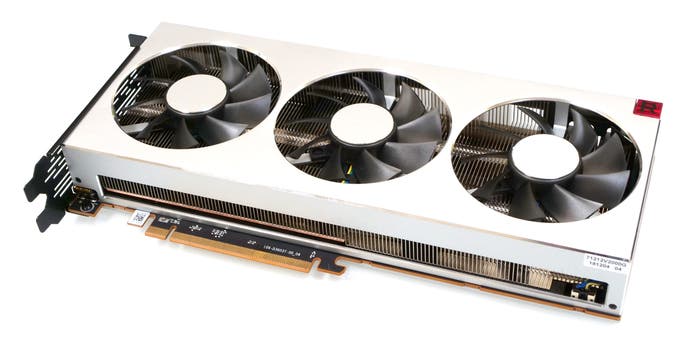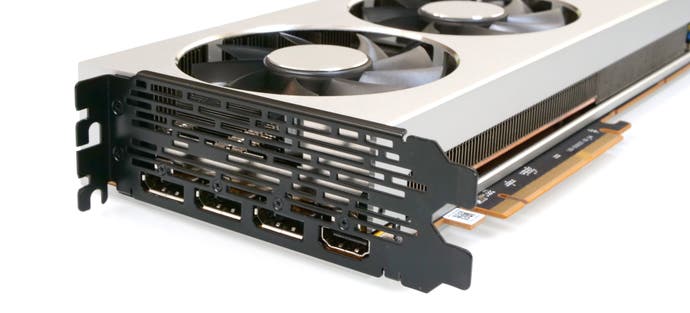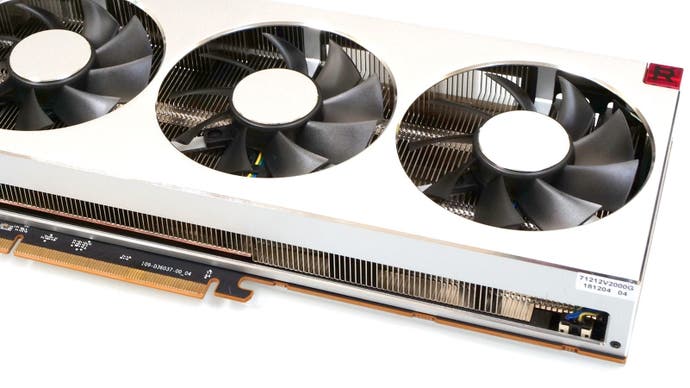AMD Radeon 7 review: taking the fight to RTX 2080
Does 16GB of ultra-fast RAM beat cutting-edge ray tracing tech?
At what point did 4K gaming finally become viable without having to compromise too much on graphics settings? For my money, it would the arrival of the Titan X Pascal in August 2016, followed by its stablemates later on: GTX 1080 Ti and Titan Xp. Nvidia reached new heights in performance with its GP102 processor. AMD had no answer, and RTX duly followed. Two-and-a-half years on from GP102's debut, there is now a powerful Radeon that is indeed competitive - and while it lacks the latest innovations in graphics technology, it is fast, and it has its own unique selling point: 16GB of ultra-fast HBM2 memory.
Going into this one, I had my doubts that Radeon 7 could bring the necessary horsepower to justify its price-point. After all, the Vega 20 processor that beats at its heart is essentially using the same technology as the RX Vega 64. The architecture is mostly the same, and the chip itself still has the same 64 compute units, or 4096 shaders. In fact, Radeon 7 is actually using salvage parts - only 60 CUs are active, for 3840 shaders in total. Increasing performance comes from two approaches then: first of all, compute power is increased as the move to 7nm fabrication allows AMD to increase the chip's clock speeds. And secondly, the memory interface is twice as wide - a 4096-bit bus (!) delivers a vast amount of bandwidth.
The memory spec looks impressive then, but the increase in peak compute does seem somewhat underwhelming and claims over 30 point increases over Radeon RX Vega 64 seemed unduly optimistic when I first took a look at the spec. However, you can't argue with measured performance and there's no doubt that AMD has delivered exactly what it said it would. Across the next few pages you will see that by and large, Radeon 7 is competitive with RTX 2080 and the older Pascal GP102-based products, including the popular GTX 1080 Ti.

AMD is asking for $699/£649 for the Radeon 7 though, meaning that in terms of gaming performance, not much has changed in value terms since the arrival of the GTX 1080 Ti almost two years ago. Nvidia's own successor at the same price-point - RTX 2080 - offers up much the same level of rasterisation performance, but the green team needs to be commended for its efforts in trying redefine graphics via hardware accelerated ray tracing and machine learning. At its heart, Radeon 7 is still Vega - a technology that was already late to market and features none of those technologies. In essence then, AMD is asking us to weigh up the advantages of the RTX feature set against double the framebuffer memory provided by Radeon 7.
Pictured below, you'll see the card that AMD sent us for review. It's the reference model Radeon 7, featuring a high quality full-metal casing (including backplate), a substantial heatsink, and three fans. The card has a 300W TDP, meaning that two eight-pin PCI Express inputs are required to power it. Third party cards may differ, but the AMD reference model features its usual IO, consisting of three DisplayPorts and a single HDMI 2.0 output. It's an understated card compared to some of the third party efforts we see these days, but the bright red Radeon highlighting is quite nice. It's a clear upgrade over prior AMD reference designs, marred only by our sample's fan noise being rather loud compared to Nvidia's RTX 2080 and even 2080 Ti. This is a bit of a puzzle as the card itself is never super-hot to the touch in the way that Vega was, and complete system power consumption at the wall was measured at around 370W.

| GPU cores | Boost Clock | TFLOPs | Memory | Memory Bandwidth | |
|---|---|---|---|---|---|
| Radeon 7 | 3840 | 1800MHz | 14.2 | 16GB HBM2 | 1024GB/s |
| Vega 64 | 4096 | 1546MHz | 12.7 | 8GB HBM2 | 484GB/s |
| RTX 2080 FE | 2944 | 1800MHz | 10.6 | 8GB GDDR6 | 448GB/s |
| GTX 1080 Ti | 3584 | 1582MHz | 11.3 | 11GB GDDR5X | 484GB/s |
Onto the big question then - does the Radeon 7's remarkable 16GB of HBM2 memory actually deliver any tangible benefits? AMD's reviewer's guide points out that using a monitoring tool, it has noted several titles that exceed 8GB of memory - which is the limit of Nvidia's competing RTX 2080. However, if the inference is that this represents a limiting factor for RTX 2080, this isn't backed by much evidence. The truth is that many games dynamically adjust how VRAM is utilised, depending on how much there is. Call of Duty, for example, has used VRAM as a cache for many years now - but higher memory utilisation doesn't translate into an improved experience. Also consider that Nvidia's memory compression technology is typically a step or two ahead of AMD's.
The reviewer's guide does come up with an interesting scenario, however. It points out that using Far Cry 5's dynamic resolution scaling technology takes VRAM utilisation over eight gigs, and says that the RTX 2080 stutters while the Radeon 7 does not. I put this to the test and found that using DRS with a target 60fps can almost double VRAM consumption at 4K resolution (!) but at the same time, both Radeon 7 and RTX 2080 maintained a locked 60fps traversing the test area AMD specified. If finding practical use-case scenarios for 16GB in gaming is so difficult, some might say that in the here and now at least, 8GB of RAM is fine for 4K gaming.
That's not to say that 16GB of memory isn't useful, however. Radeon 7 is essentially a more gaming-oriented version of a pro-level GPU, and speaking as someone who works with video editing day-in, day-out, I can easily find myself hitting GPU VRAM limits on my current card - an Nvidia Titan X Pascal 12GB. Indeed, all of the DF team moved on from 6GB/8GB cards some time ago as they were just too constrained in terms of memory.
Mixing multiple 4K streams on a timeline with taxing transitions causes no problems when editing, but can often see crashes when trying to export the project. As you'll see in the video embedded at the top of this page, I could put together a simple Adobe Premiere project using six clips and three transitions that would crash on the Titan, but export just fine on the Radeon 7. This isn't down to drivers or compute power, but 100 per cent down to GPU memory. For content creators pushing 4K video hard, Radeon 7 is still expensive - but it's offering a pro-level memory allocation that make working with challenging projects easier.
However, primarily it's all about the games, right? So let's kick off our detailed performance analysis across ten titles, old and new.
AMD Radeon 7 Analysis
- Introduction, Hardware Breakdown [This Page]
- Assassin's Creed Odyssey/Unity, Battlefield 1, Crysis 3 - Performance Analysis Part 1
- Far Cry 5, Far Cry Primal, Ghost Recon Wildlands - Performance Analysis Part 2
- Rise of the Tomb Raider, Shadow of the Tomb Raider, The Witcher 3 - Performance Analysis Part 3
- AMD Radeon 7 - the Digital Foundry verdict

